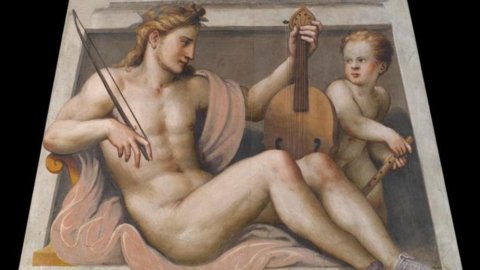Il Mar, the Art Museum of the City of Ravenna continues its investigation into topics of great interest yet to be explored with the ambitious exhibition project entitled "The enchantment of the fresco", scheduled from 16 February to 15 June 2014, realized thanks to the precious support of the Cassa di Risparmio di Ravenna Foundation.
The exhibition, curated by Claudio Spadoni, scientific director of the Mar, and by Luca Ciancabilla, researcher at the Department of Cultural Heritage of the University of Bologna (Ravenna branch), is divided into six sections, arranged according to a historical-chronological address: from early sixteenth-seventeenth-century blocks, to eighteenth-century transports, including those from Pompeii and Herculaneum, to nineteenth-century tears, up to the detached sinopias in the seventies of the twentieth century.
More than fifty years ago Roberto Longhi was the first to feel, also in the wake of the success of the first "Exhibition of Detached Frescoes" held at the Forte Belvedere in Florence (1957), the need to set up an exhibition that could retrace the secular history and fortune of the practice of detaching wall paintings, a history of taste, of collecting, of restoration, and protection of that fundamental part of the ancient Italian pictorial heritage.
The first detachment operations date back to the times of Vitruvius and Pliny, according to a technique which involved the removal of the works together with all the plaster and the wall that housed them. The so-called "massello", which favored the transport to Rome of paintings from otherwise immovable conquered lands, after centuries of oblivion found new fortune starting from the Renaissance - in the north as in the center of the Peninsula - favoring the conservation for posterity of portions of frescoes which otherwise would have been lost forever. Thus, in a time span between the XNUMXth and XNUMXth centuries, the weeping Magdalene by Ercole de Roberti from the Pinacoteca Nazionale di Bologna, The group of little angels by Melozzo da Forli from the Vatican Museums, The Madonna della Mani by Pinturicchio were transferred: works these on display.
A difficult and costly modus operandi which, starting from the second quarter of the Enlightenment, was joined, and slowly replaced, by the more innovative and practical technique of the strappo, a practice which, using a special glue, allowed the frescoes to be torn off and then taken to a canvas. A real revolution in the field of restoration, conservation, but also of collecting the Italian mural heritage. Thus while in the newly rediscovered Herculaneum and Pompeii the most beautiful wall paintings of antiquity were transported on a new support and therefore to the Museum of Portici, the revolution of the tear was spreading throughout the rest of Italy.
Nothing would ever be the same again. From that moment on and until the end of the XNUMXth century, a large number of masterpieces of Italian painting were torn from the vaults of churches and chapels, from the walls of public and private buildings that had housed them for centuries, to be transported to safer, in the collections and noble and princely galleries of Italy and half of Europe. Often, in fact, implicit collecting motivations are hidden behind overt conservation needs.
Andrea del Castagno, Bramante, Bernardino Luini, Garofalo, Girolamo Romanino, Correggio, Moretto, Giulio Romano, Niccolò dell'Abate, Pellegrino Tibaldi, Veronese, Ludovico and Annibale Carracci, Guido Reni, Domenichino, Guercino: all the great masters of Italian art between the mid-eighteenth century and the end of the nineteenth century were the object of the attention of the extractors: Antonio Contri, Giacomo and Pellegrino Succi, Antonio Boccolari, Filippo Balbi, Stefano Barezzi, Giovanni Rizzoli, Giovanni Secco Suardo , Giuseppe Steffanoni, they too, like the illustrious artists mentioned above, and like some of the most beautiful paintings of Herculaneum and Pompeii, will be the protagonists of the Mar exhibition.
But the extractist practice will experience its most fortunate season in the last century, when, starting from the second post-war period, an impressive number of frescoes were torn up and detached. The damage caused to some of the main Italian pictorial monuments by war bombings, the belief that the only way to go to avoid irreparable damage such as those to Mantegna in Padua, Tiepolo in Vicenza, Buffalmacco and Benozzo Gozzoli in Pisa , ensured that starting in the 1940s the most impressive snatch and deadlift campaign that Italy has ever known was launched. In the event of a new war, even that fundamental portion of our pictorial heritage could have been saved by placing it in air-raid shelters, as had been done since XNUMX with the canvases and plates of the major museums of the nation.
Thus began the so-called "season of detachments" and of the "hunt for sinopias", the preparatory drawings that the fourteenth and fifteenth-century masters had left as a trace under the plaster. Because as in the previous two centuries, even then the evident and just conservation and safeguarding reasons were joined by others, we would say, of different interest. If in the XNUMXth century it was private collectors who favored the transport of the frescoes, now it was the art historians and museums of the rebuilt nation who asked for the diffusion of the extractive technique on a wider scale. These interested in studying the graphic works, i.e. the sinopias, of painters who had left very little on paper for the purpose, the others in being able to dispose of otherwise unapproachable masterpieces of Italian art, making them easily accessible to all.
The Flood in Florence did the rest, showing the whole world the precariousness that conditioned the life of the most extraordinary Italian frescoes. Thus, to escape certain death, Giotto, Buffalmacco, Altichiero, Vitale da Bologna, Pisanello, Signorelli, Perugino, Pontormo, Tiepolo left forever the wall that had guarded them for centuries, finding homes in some of the most important museums in the nation and now, for four months, in the halls of the Mar of Ravenna.





